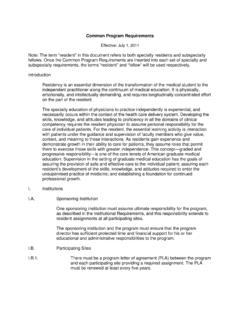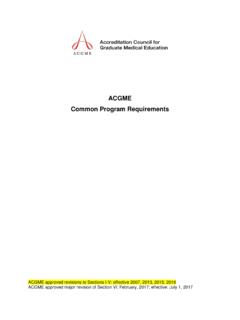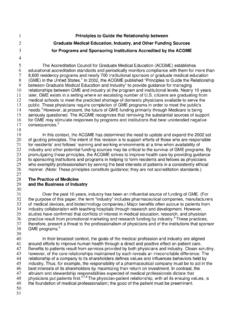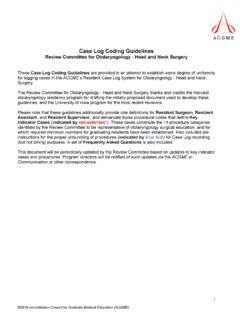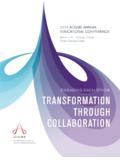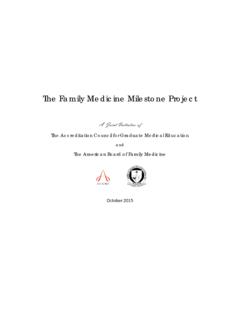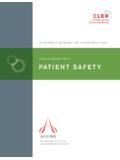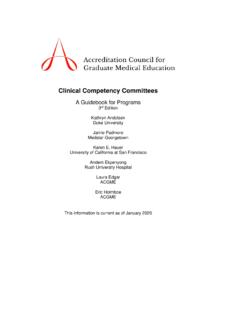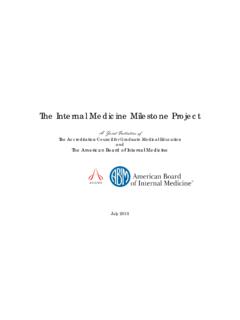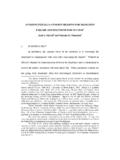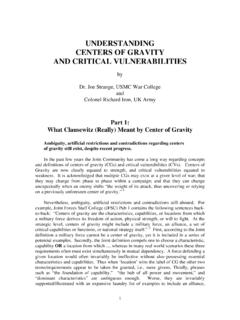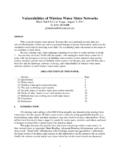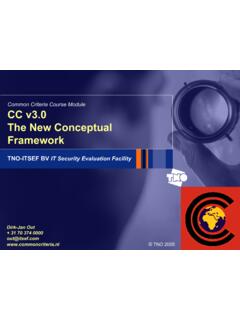Transcription of Common Program Requirements - ACGME
1 ACGME Common Program Requirements Section VI with Background and Intent ACGME approved major revision of Section VI: February, 2017; effective: July 1, 2017 Common Program Requirements Section VI with Background and Intent 2017 Accreditation Council for Graduate Medical Education ( ACGME ) Page 1 of 19 Common Program Requirements Note: The term resident in this document refers to both specialty residents and subspecialty fellows. Once the Common Program Requirements are inserted into each set of specialty and subspecialty Requirements , the terms resident and fellow will be used respectively. Where applicable, text in italics describes the underlying philosophy of the Requirements in that section.
2 These philosophic statements are not Program Requirements and are therefore not citable. The Background and Intent text in the boxes below has been developed to provide greater detail regarding the intention behind specific Requirements , as well as guidance on how to implement the Requirements in a way that supports excellence in residency education. Background and Intent: In developing the revised Requirements , the Common Program Requirements Phase 1 Task Force considered all available information, including relevant literature, written comments received from the graduate medical education community and the public, and testimony provided during the ACGME Congress on the Resident Learning and Working Environment.
3 Deliberations of the Task Force were guided by the need to develop Requirements that: (1) emphasize that graduate medical education programs are designed to provide professional education rather than vocational training; (2) are based on the best available evidence; and (3) support the philosophy outlined below. VI. The Learning and Working Environment Residency education must occur in the context of a learning and working environment that emphasizes the following principles: Excellence in the safety and quality of care rendered to patients by residents today Excellence in the safety and quality of care rendered to patients by today s residents in their future practice Excellence in professionalism through faculty modeling of.
4 O the effacement of self-interest in a humanistic environment that supports the professional development of physicians o the joy of curiosity, problem-solving, intellectual rigor, and discovery Commitment to the well-being of the students, residents, faculty members, and all members of the health care team Background and Intent: The revised Requirements are intended to provide greater flexibility within an established framework, allowing programs and residents more discretion to structure clinical education in a way that best supports the above principles of professional development. With this increased flexibility comes the responsibility for programs and residents to adhere to the 80-hour maximum weekly limit (unless a rotation-specific exception is granted by a Review Committee), and to utilize flexibility in a manner that optimizes patient safety, resident education, and resident well-being.
5 The Requirements are intended to support the development of a sense of professionalism by encouraging residents to make decisions based on patient needs and their own well-being, without fear of jeopardizing their Program s accreditation Common Program Requirements Section VI with Background and Intent 2017 Accreditation Council for Graduate Medical Education ( ACGME ) Page 2 of 19 status. In addition, the proposed Requirements eliminate the burdensome documentation requirement for residents to justify clinical and educational work hour variations. Clinical and educational work hours represent only one part of the larger issue of conditions of the learning and working environment, and Section VI has now been expanded to include greater attention to patient safety and resident and faculty member well-being.
6 The Requirements are intended to support programs and residents as they strive for excellence, while also ensuring ethical, humanistic training. Ensuring that flexibility is used in an appropriate manner is a shared responsibility of the Program and residents. With this flexibility comes a responsibility for residents and faculty members to recognize the need to hand off care of a patient to another provider when a resident is too fatigued to provide safe, high quality care and for programs to ensure that residents remain within the 80-hour maximum weekly limit. Patient Safety, Quality Improvement, Supervision, and Accountability Patient Safety and Quality Improvement All physicians share responsibility for promoting patient safety and enhancing quality of patient care.
7 Graduate medical education must prepare residents to provide the highest level of clinical care with continuous focus on the safety, individual needs, and humanity of their patients. It is the right of each patient to be cared for by residents who are appropriately supervised; possess the requisite knowledge, skills, and abilities; understand the limits of their knowledge and experience; and seek assistance as required to provide optimal patient care. Residents must demonstrate the ability to analyze the care they provide, understand their roles within health care teams, and play an active role in system improvement processes. Graduating residents will apply these skills to critique their future unsupervised practice and effect quality improvement measures.
8 It is necessary for residents and faculty members to consistently work in a well-coordinated manner with other health care professionals to achieve organizational patient safety goals. ) Patient Safety ).(1) Culture of Safety A culture of safety requires continuous identification of vulnerabilities and a willingness to transparently deal with them. An effective organization has formal mechanisms to assess the knowledge, skills, and attitudes of its personnel toward safety in order to identify areas for improvement. ).(1).(a) The Program , its faculty, residents, and fellows must actively participate in patient safety systems and contribute to a culture of safety.
9 (Core) Common Program Requirements Section VI with Background and Intent 2017 Accreditation Council for Graduate Medical Education ( ACGME ) Page 3 of 19 ).(1).(b) The Program must have a structure that promotes safe, interprofessional, team-based care. (Core) ).(2) Education on Patient Safety programs must provide formal educational activities that promote patient safety-related goals, tools, and techniques. (Core) Background and Intent: Optimal patient safety occurs in the setting of a coordinated interprofessional learning and working environment. ).(3) Patient Safety Events Reporting, investigation, and follow-up of adverse events, near misses, and unsafe conditions are pivotal mechanisms for improving patient safety, and are essential for the success of any patient safety Program .
10 Feedback and experiential learning are essential to developing true competence in the ability to identify causes and institute sustainable systems-based changes to ameliorate patient safety vulnerabilities. ).(3).(a) Residents, fellows, faculty members, and other clinical staff members must: ).(3).(a).(i) know their responsibilities in reporting patient safety events at the clinical site; (Core) ).(3).(a).(ii) know how to report patient safety events, including near misses, at the clinical site; and, (Core) ).(3).(a).(iii) be provided with summary information of their institution s patient safety reports. (Core) ).(3).(b) Residents must participate as team members in real and/or simulated interprofessional clinical patient safety activities, such as root cause analyses or other activities that include analysis, as well as formulation and implementation of actions.
